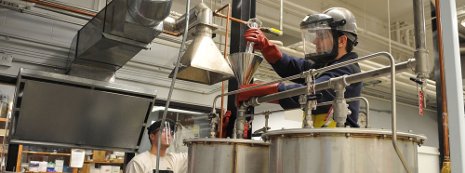Document Type
Article
Publication Date
7-25-2018
Abstract
Increasing the diversity of lignocellulosic feedstocks accepted by a regional biorefinery has the potential to improve the environmental footprint of the facility; harvest,storage, and transportation logistics; and biorefinery economics. However, feedstocks can vary widely in terms of their biomass yields and quality characteristics (chemical composition, moisture content, etc.). To investigate how the diversity of potential biofuel cropping systems and feedstock supply might affect process and field‐scale ethanol yields, we processed and experimentally quantified ethanol production from five different herbaceous feedstocks: two annuals (corn stover and energy sorghum) and three perennials (switchgrass, miscanthus, and mixed prairie). The feedstocks werepretreated using ammonia fiber expansion (AFEX), hydrolyzed at high solid loading(~17%–20% solids, depending on the feedstock), and fermented separately using microbes engineered to utilize xylose: yeast (Saccharomyces cerevisiae Y128) or bacteria (Zymomonas mobilis 8b). The field‐scale ethanol yield from each feedstock was dependent on biomass quality and cropping system productivity; however, biomass yield had a greater influence on the ethanol yield for low‐productivity crops, while biomass quality was the main driver for ethanol yields from high‐yielding crops. The process ethanol yield showed similar variability across years and feedstocks. A low process yield for corn stover was determined to result from inhibition of xylose utilization by unusually elevated levels of hydroxycinnamates (p‐coumaric and ferulicacids) in the untreated biomass and their acid and amide derivatives in the resulting hydrolyzate. This finding highlights the need to better understand factors that influence process ethanol yield and biomass quality. Ultimately we provide evidence that most feedstocks fall within a similar range of process ethanol yield, particularly for the more resistant strain Z. mobilis 8b. This supports the claim that the refinery can successfully diversify its feedstock supply, enabling many social and environmental benefits that can accrue due to landscape diversification.
Publication Title
Global Change Biology Bioenergy
Creative Commons License

This work is licensed under a Creative Commons Attribution 4.0 International License.
Recommended Citation
Zhang, Y.,
Oates, L. G.,
Serate, J.,
Xie, D.,
Pohlman, E.,
Bukhman, Y.,
Ong, R. G.,
&
et al.
(2018).
Diverse lignocellulosic feedstocks can achieve high field‐scale ethanol yields while providing flexibility for the biorefinery and landscape‐level environmental benefits.
Global Change Biology Bioenergy.
http://doi.org/10.1111/gcbb.12533
Retrieved from: https://digitalcommons.mtu.edu/chemical-fp/6
Version
Publisher's PDF


Publisher's Statement
© 2018 The Authors. Article deposited here in compliance with publisher policy. Publisher's version of record: https://doi.org/10.1111/gcbb.12533